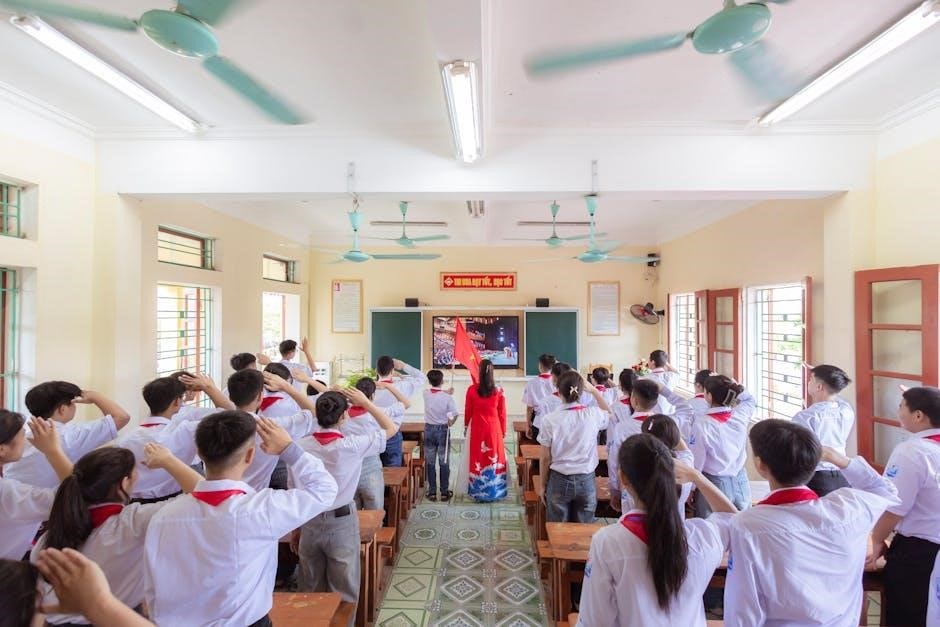normal sperm analysis report pdf
A sperm analysis report is a detailed diagnostic tool assessing male fertility through parameters like sperm count, motility, and morphology. It’s crucial for evaluating reproductive health and guiding treatment plans, standardized by WHO guidelines to ensure accurate assessments.
1.1. Purpose of a Sperm Analysis Report
A sperm analysis report serves as a diagnostic tool to evaluate male fertility by assessing sperm parameters such as concentration, motility, and morphology. Its primary purpose is to identify potential issues affecting fertility and guide treatment decisions. Standardized by WHO guidelines, the report ensures accurate and reliable results, providing insights into sperm health and reproductive potential. By measuring key metrics, it helps diagnose conditions like oligospermia or asthenospermia, offering a clear foundation for clinical decisions and fertility management.
1.2. Importance in Male Fertility Evaluation
Sperm analysis is pivotal in male fertility evaluation, providing critical insights into reproductive health. It identifies issues like low sperm count or poor motility, which can hinder conception. By assessing parameters such as concentration, motility, and morphology, the report helps diagnose underlying conditions affecting fertility. This information is essential for clinical decisions, guiding treatments like IVF or lifestyle changes. A normal report offers reassurance, while abnormalities highlight areas for intervention, making it a cornerstone in evaluating and addressing male infertility effectively.
1.3. Standard Parameters Assessed in the Report
A standard sperm analysis report evaluates key parameters to assess male reproductive health. These include sperm concentration (count), motility (percentage of moving sperm), and morphology (percentage of normal-shaped sperm). Additional factors such as semen volume, pH levels, and DNA fragmentation are also examined. These parameters provide a comprehensive understanding of sperm quality and functionality. The report adheres to WHO guidelines, ensuring consistent and reliable results. By analyzing these metrics, healthcare providers can identify potential fertility issues and recommend appropriate interventions, making it a vital tool for evaluating and improving male reproductive health.

Key Parameters of a Normal Sperm Analysis Report
A normal report assesses sperm concentration, motility, morphology, semen volume, pH, and DNA fragmentation. These parameters provide insights into sperm health and fertility potential.
2.1. Sperm Concentration (Count)
Sperm concentration refers to the number of sperm per milliliter of semen, a critical factor in fertility. A normal concentration is typically above 15 million sperm/ml, as per WHO guidelines. This parameter is essential for assessing male fertility potential, as lower counts may reduce the chances of conception. Factors like lifestyle, health conditions, and environmental exposures can influence sperm concentration. Even with normal motility or morphology, low concentration can impact fertility, potentially requiring treatments like IVF. Monitoring and addressing lifestyle factors can help improve sperm count and overall reproductive health.
2.2. Sperm Motility (Total Motile Count)
Sperm motility measures the ability of sperm to move efficiently, a key factor in reaching and fertilizing an egg. The total motile count (TMC) is the number of moving sperm per ejaculate. According to WHO guidelines, normal motility is at least 40% of sperm showing progressive movement. Poor motility, or asthenozoospermia, can significantly reduce fertility potential. Factors like oxidative stress, infections, or lifestyle choices can impair motility. Even with normal concentration and morphology, low motility can hinder conception, emphasizing the importance of addressing underlying causes to improve reproductive outcomes.
2.3. Sperm Morphology (Normal Shape and Structure)
Sperm morphology evaluates the shape and structure of sperm, focusing on the head, neck, midpiece, and tail. Normal morphology is defined as at least 4% of sperm having a normal shape, according to WHO standards. Abnormalities in the head, such as irregular size or shape, or defects in the tail or midpiece, can impair sperm function. Proper morphology is essential for sperm to penetrate the egg and achieve fertilization. Lifestyle factors, such as smoking or obesity, can negatively impact sperm shape, emphasizing the importance of healthy habits to maintain optimal sperm structure and fertility potential.
2.4. Semen Volume
Semen volume refers to the amount of ejaculate produced during ejaculation, typically ranging from 1.5 mL to 5 mL in normal cases. A minimum of 1.5 mL is considered adequate for optimal sperm function. Semen volume is influenced by factors like hydration levels, hormonal balance, and the health of accessory glands such as the seminal vesicles. Low semen volume may indicate issues like blockages or infections, while high volume can sometimes dilute sperm concentration. Accurate measurement of semen volume is crucial in assessing overall semen quality and fertility potential.
2.5. pH Level of Semen
The pH level of semen measures its acidity or alkalinity, playing a crucial role in sperm health. A normal pH range is between 7.2 and 8.0, indicating a healthy environment for sperm survival and function. Abnormal pH levels, either too acidic or too alkaline, can impair sperm viability and motility, potentially leading to fertility issues. Factors influencing semen pH include infections, inflammation, or blockages in the reproductive tract. Maintaining a normal pH is essential for optimal sperm function and overall fertility, making it a vital parameter in a sperm analysis report.
2.6. Sperm DNA Fragmentation
Sperm DNA fragmentation refers to the degree of damage in the DNA of sperm, which is a critical factor in male fertility. High fragmentation levels can impair fertility by affecting embryo development and increasing miscarriage risks. Factors like smoking, obesity, oxidative stress, and certain medical conditions can contribute to increased DNA fragmentation. Measured using tests like the DNA Fragmentation Index (DFI), normal levels are typically below 15-20%. Elevated fragmentation may require lifestyle changes or medical interventions to improve fertility outcomes and sperm health.

Normal Ranges According to WHO Guidelines
WHO guidelines define normal sperm parameters, ensuring standardized fertility evaluations. These ranges, updated in the 6th edition, include sperm count, motility, and morphology thresholds.
3.1. WHO 6th Edition Manual Updates
The 6th edition of the WHO manual introduces updated reference values for semen parameters, reflecting advancements in fertility research. Key updates include revised thresholds for sperm concentration, motility, and morphology, ensuring more accurate fertility assessments. These changes help standardize interpretations across laboratories and clinics, providing clearer guidelines for evaluating male reproductive health. The manual also incorporates new methodologies for sample analysis, enhancing the reliability of sperm analysis reports. These updates are crucial for both clinical practice and research, offering a contemporary framework for understanding sperm health.
3.2. Minimum Thresholds for Normal Sperm Parameters
The WHO 6th Edition Manual establishes minimum thresholds for normal sperm parameters to guide clinical evaluations. For sperm concentration, a normal value is ≥15 million sperm per milliliter. Total motility should be ≥40%, with progressive motility ≥32%. Morphology requires ≥4% normal forms under strict criteria. Semen volume should be ≥1.5 mL, and pH should be between 7.2 and 8.0. These thresholds help standardize assessments, ensuring consistent interpretations of sperm health and fertility potential. They also aid in identifying abnormalities that may require further diagnostic evaluation or treatment.
3.3. Comparison of 5th and 6th Edition Standards
The WHO 5th and 6th Edition standards for sperm analysis differ in reference values and criteria. The 6th Edition lowered the normal sperm concentration threshold from 20 million/mL to 15 million/mL and updated motility standards, increasing total motility from 50% to 40% and progressive motility from 30% to 32%. Morphology criteria became stricter, reducing the normal forms threshold from 15% to 4%. These changes reflect improved research and clinical insights, ensuring more accurate assessments of male fertility. The 6th Edition also introduced sperm DNA fragmentation as a key parameter for evaluation.

Interpreting a Sperm Analysis Report
Interpreting a sperm analysis report involves understanding each parameter’s normal range, identifying abnormalities, and guiding next steps for fertility assessment or treatment. Healthcare providers can help discuss results.
4.1. Understanding the Results
Understanding the results of a sperm analysis report involves interpreting various parameters such as sperm concentration, motility, and morphology. Each parameter is compared to normal ranges to assess fertility potential. High sperm concentration and motility indicate healthy semen quality, while abnormal morphology may suggest potential fertility issues. The report also evaluates semen volume, pH levels, and DNA fragmentation. Normal results are typically highlighted, while abnormal findings may require further investigation or lifestyle changes. Consulting a healthcare provider is essential to accurately interpret the results and determine the next steps for fertility evaluation or treatment.
4.2. Color-Coded Reports (Green for Normal, Amber for Abnormal)
Many sperm analysis reports use color-coding to simplify result interpretation. Green indicates normal parameters, while amber highlights abnormal values. This system allows quick identification of potential issues. For example, green for sperm concentration means it falls within the normal range, while amber suggests low counts. This visual approach helps patients and healthcare providers focus on specific areas needing attention. Color-coding enhances clarity and ensures effective communication of test results, making it easier to prioritize follow-up actions or treatments based on the findings.
4.3. Role of Motility, Concentration, and Morphology
Motility, concentration, and morphology are critical parameters in assessing sperm health. Motility measures the ability of sperm to move effectively, concentration indicates the number of sperm per milliliter, and morphology evaluates the shape and structure. Together, these factors determine fertility potential. Low motility or abnormal morphology can hinder fertilization, even with normal concentration. Conversely, high concentration with poor motility may also reduce fertility chances. These parameters provide a comprehensive understanding of sperm function and overall reproductive health, guiding further diagnostic or treatment steps for individuals or couples trying to conceive.

Factors Influencing Sperm Quality
Lifestyle, environmental, and medical factors significantly impact sperm health. Diet, smoking, and alcohol affect sperm production, while pollution and heat exposure can impair motility and morphology.
5.1. Lifestyle Factors (Diet, Smoking, Alcohol)
Lifestyle factors significantly influence sperm quality. A balanced diet rich in antioxidants, vitamins, and minerals, such as zinc and selenium, supports sperm health. Smoking and excessive alcohol consumption impair sperm production and motility. Antioxidant-rich foods like berries, nuts, and leafy greens help combat oxidative stress, which damages sperm DNA. Conversely, a diet high in processed foods and trans fats can negatively affect sperm parameters. Regular exercise and maintaining a healthy weight also promote sperm health, while obesity can reduce testosterone levels and sperm count. Avoiding smoking and limiting alcohol intake are crucial for optimal sperm quality.
5.2. Environmental Factors (Pollution, Heat Exposure)
Environmental factors play a significant role in sperm health. Exposure to air and water pollution, including toxins like heavy metals and pesticides, can impair sperm production and motility. Heat exposure, such as from hot tubs, saunas, or tight clothing, can elevate scrotal temperature, damaging sperm development. Occupational hazards, like working with chemicals or in high-heat environments, also pose risks. Reducing exposure to pollutants and avoiding excessive heat are crucial for maintaining healthy sperm parameters. These external factors can significantly impact fertility, even in men with otherwise normal sperm analysis results.
5.3. Medical Conditions Affecting Sperm Health
Medical conditions significantly impact sperm health and fertility. Varicocele, a swelling of scrotal veins, can reduce sperm count and motility. Infections like epididymitis or orchitis may damage sperm production. Hormonal imbalances, particularly low testosterone levels, disrupt sperm development. Chronic illnesses, such as diabetes, can impair blood flow and nerve function, affecting sperm quality. Autoimmune disorders, where the immune system attacks sperm, also reduce fertility. Genetic conditions like Klinefelter syndrome or Y-chromosome deletions can cause abnormal sperm formation. Additionally, thyroid disorders, such as hyperthyroidism or hypothyroidism, can interfere with hormone balance, further affecting sperm health.

The Role of Seminal Plasma and Liquefaction
Seminal plasma nourishes sperm with enzymes and proteins, while liquefaction enables sperm mobility by breaking down semen coagulum, essential for sperm survival and function.
6.1. Normal Semen Liquefaction Time
Normal semen liquefaction typically occurs within 20 to 30 minutes after ejaculation. This process is crucial for sperm mobility, as it allows the coagulated semen to transition into a liquid state, enabling sperm to move freely. Delayed or rapid liquefaction may indicate underlying issues, such as infections or enzyme deficiencies, which can affect sperm function. Proper liquefaction ensures optimal sperm viability and motility, supporting fertility potential. This parameter is commonly evaluated in sperm analysis reports to assess semen quality and overall reproductive health.
6.2. Importance of Seminal Plasma Composition
Seminal plasma composition plays a vital role in sperm function and fertility. It provides essential nutrients, enzymes, and antioxidants that protect sperm from oxidative stress and support their survival. Components like zinc, citrate, and fructose maintain sperm energy production and motility. Abnormal seminal plasma composition can impair sperm quality, leading to reduced fertility. Accurate analysis of its composition in a sperm analysis report helps diagnose underlying issues, such as infections or hormonal imbalances, ensuring targeted treatment for improved reproductive outcomes. Its balance is critical for maintaining healthy sperm parameters and overall male fertility potential.

Sperm Mitochondria and Energy Production
Sperm mitochondria produce ATP, essential for sperm movement. Healthy mitochondrial function is crucial for maintaining sperm motility and overall fertility potential through efficient energy production.
7.1. Mitochondrial Structure and Function
Sperm mitochondria are located in the midpiece of the sperm and have a unique double-membrane structure with cristae, maximizing energy production. They generate ATP through oxidative phosphorylation, essential for sperm motility. The spiral arrangement of mitochondria in the sperm midpiece optimizes energy output, ensuring efficient movement and survival during fertilization. Proper mitochondrial function is critical for sperm quality, as ATP fuels the high-energy demands of sperm movement and capacitation. Any dysfunction can impair sperm motility and fertility potential, emphasizing the importance of mitochondrial health in semen analysis.
7.2. Impact of Mitochondrial Health on Sperm Motility
Mitochondrial health plays a crucial role in sperm motility, as these organelles produce ATP, the energy required for sperm movement. Damaged or dysfunctional mitochondria can lead to reduced ATP production, resulting in poor sperm motility. The midpiece of the sperm, where mitochondria are densely packed, is vital for propelling the sperm forward. Any disruption in mitochondrial function can impair sperm movement, reducing fertility potential. Healthy mitochondrial function is essential for maintaining progressive motility, a key parameter in semen analysis, ensuring sperm can successfully reach and fertilize the egg.

Clinical Significance of Normal Results
A normal sperm analysis report confirms optimal sperm health, indicating strong fertility potential. It reassures couples trying to conceive, confirming parameters within healthy ranges.
8.1. Fertility Potential
A normal sperm analysis report indicates healthy sperm parameters, suggesting strong fertility potential. Sperm concentration, motility, and morphology within normal ranges enhance the likelihood of successful conception. These results align with WHO guidelines, confirming the semen sample’s ability to support natural conception or assisted reproductive techniques. Normal sperm function is critical for fertilization, as motile sperm with healthy structure can effectively reach and penetrate the egg. This positive outcome provides reassurance for couples trying to conceive, emphasizing the man’s reproductive health is within optimal ranges for contributing to a pregnancy.
8.2. Reassurance for Couples Trying to Conceive
A normal sperm analysis report provides significant reassurance for couples trying to conceive. It confirms that male fertility is within healthy ranges, reducing anxiety and uncertainty. Couples can feel more confident in their ability to conceive naturally or through assisted reproductive methods. A normal report also offers clarity, helping couples focus on other aspects of family planning without undue stress. This positive outcome can alleviate emotional pressure and provide a clear starting point for achieving their reproductive goals.

How to Obtain a Sperm Analysis Report
To obtain a sperm analysis report, visit a fertility clinic or healthcare provider. Provide a semen sample following their guidelines. Results typically take a few days.
9.1. Sample Collection Guidelines
Collecting a semen sample for analysis requires careful adherence to guidelines to ensure accurate results. Abstain from ejaculation for 2–7 days before collection. Use a sterile container provided by the clinic. Avoid using lubricants or spermicides. Masturbate in a private, stress-free environment and collect all ejaculate. If unable to collect at the clinic, transport the sample within 1 hour. Label the container with your name and date. Return the sample promptly to avoid delays. Follow any additional instructions provided by your healthcare provider to ensure the integrity of the sample.
9.2. Timing and Preparation for the Test
Proper timing and preparation are crucial for accurate sperm analysis results. Abstinence from ejaculation for 2–7 days is typically recommended. Schedule the test in the morning, as hormone levels are highest. Avoid alcohol, drugs, and medications that may affect sperm quality. Inform your clinician of any supplements or medications you’re taking. Arrive with a full bladder if required for additional tests. Follow all instructions provided by your healthcare provider to ensure the sample reflects your true sperm health. Timely and correct preparation helps in obtaining reliable and meaningful results for evaluation.

Common Questions About Sperm Analysis
Common questions include understanding test purpose, normal ranges, and factors affecting results. It helps assess male fertility and guides treatment decisions for couples trying to conceive.
10.1. What Does a Normal Report Mean?
A normal sperm analysis report indicates that all measured parameters fall within the reference ranges defined by the WHO guidelines. This includes sperm concentration, motility, morphology, semen volume, and pH levels. A normal result suggests that male fertility is likely not a significant contributing factor to conception challenges. However, it does not guarantee fertility, as other factors, such as female reproductive health, also play a role. A normal report provides reassurance and serves as a baseline for further evaluation if fertility issues persist.
10.2. Can a Normal Report Change Over Time?
A normal sperm analysis report can change over time due to various factors, including lifestyle changes, environmental exposures, or underlying medical conditions. Sperm quality is dynamic and can fluctuate based on factors like diet, stress, or infections. Even if a report is normal initially, it may not remain so if negative influences affect sperm health. Regular monitoring is recommended, especially for individuals trying to conceive or those exposed to potential risks. Changes in sperm parameters can occur gradually or suddenly, emphasizing the importance of repeat testing for accurate fertility assessment.
A normal sperm analysis report provides crucial insights into male fertility, highlighting the importance of understanding and maintaining sperm health for conception and reproductive well-being.
11.1. Summary of Key Points
A normal sperm analysis report assesses critical parameters like concentration, motility, morphology, and semen volume, providing insights into male fertility. These results are compared against WHO guidelines to determine normalcy. Lifestyle factors, such as diet and smoking, and environmental influences, like pollution, can impact sperm quality. Regular analysis helps identify potential issues early, ensuring timely interventions. A normal report reassures couples trying to conceive and highlights the importance of maintaining healthy habits. Understanding these factors empowers individuals to make informed decisions about their reproductive health and overall well-being.
11.2. Importance of Regular Sperm Analysis
Regular sperm analysis is crucial for monitoring male reproductive health and identifying potential fertility issues early. It allows for timely medical interventions, improving chances of conception. Routine testing helps detect changes in sperm parameters over time, which may be influenced by lifestyle or environmental factors. Regular analysis provides reassurance for those trying to conceive and aids in making informed decisions about family planning. It also enables personalized recommendations for improving sperm health, promoting overall reproductive well-being and fertility potential.




















